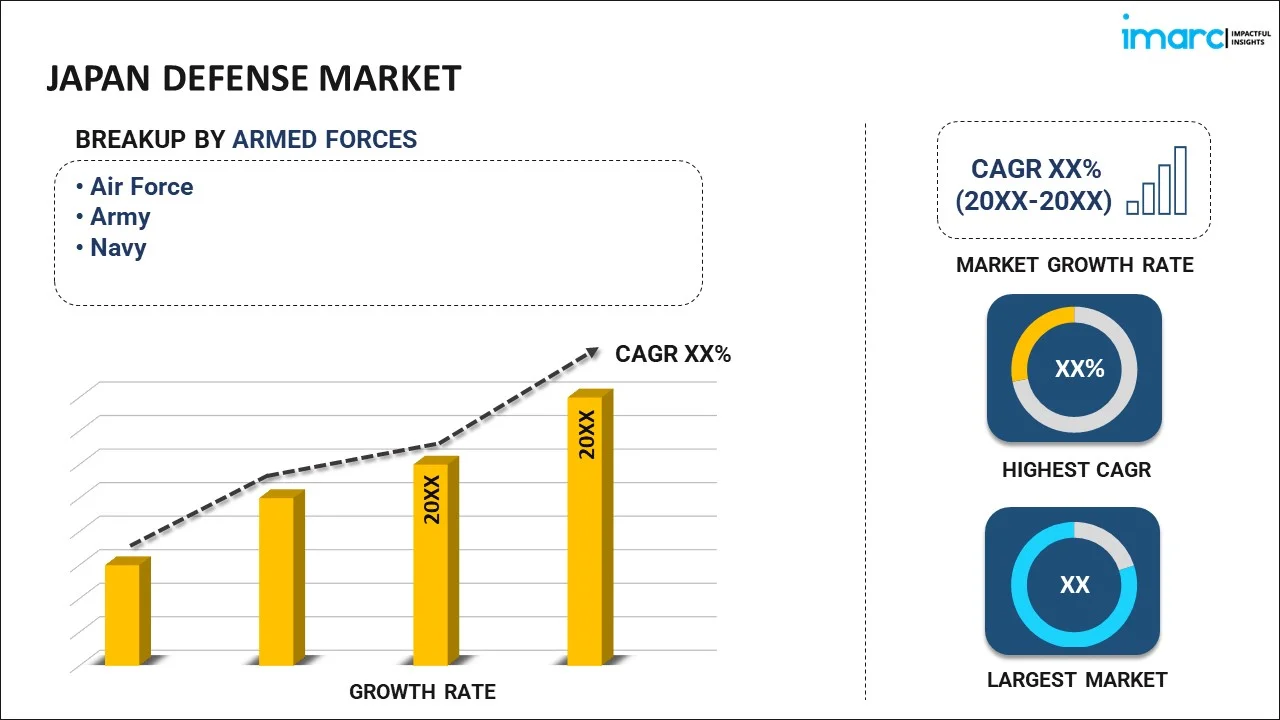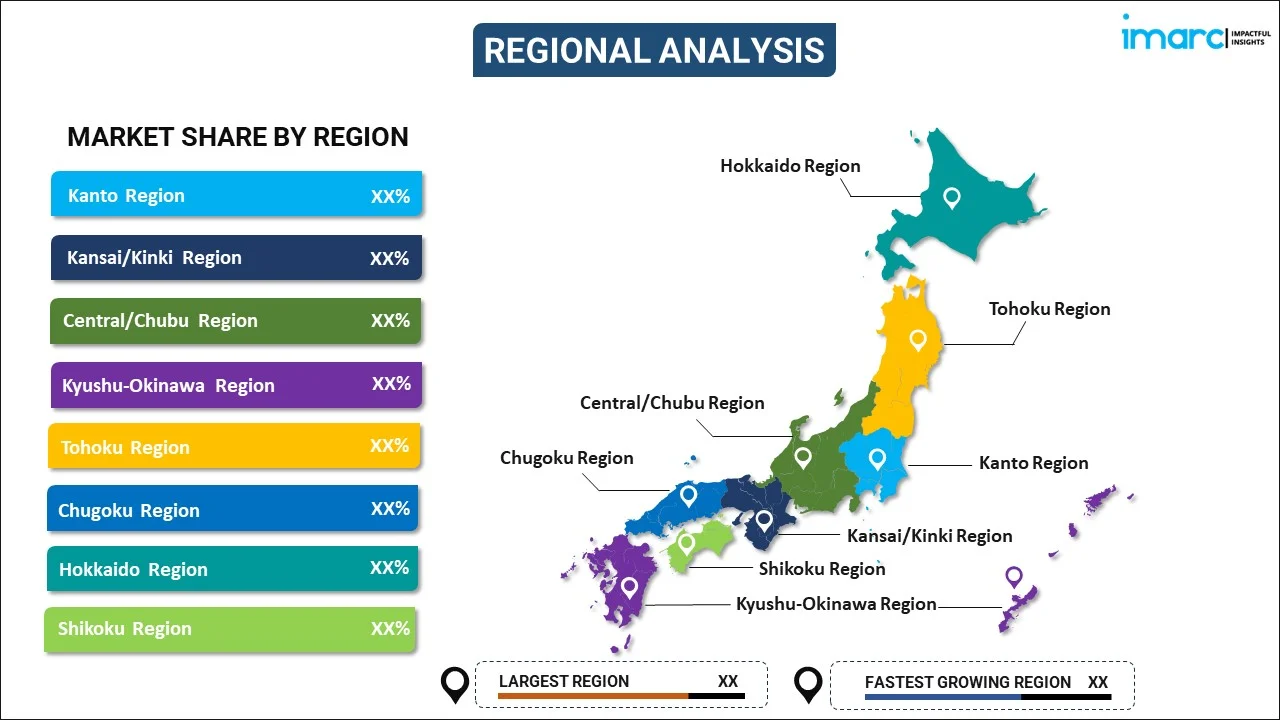
Japan Defense Market Report by Armed Forces (Air Force, Army, Navy), Type (Personnel Training and Protection, C4ISR and EW, Vehicles, Weapons and Ammunition), and Region 2025-2033
Market Overview:
Japan defense market size reached USD 35.5 Billion in 2024. Looking forward, IMARC Group expects the market to reach USD 44.1 Billion by 2033, exhibiting a growth rate (CAGR) of 2.45% during 2025-2033. The rising focus of self-defense forces on modernization and capability enhancement that assist in aligning with the nation's strategic goals and security requirements is primarily driving the market growth.
|
Report Attribute
|
Key Statistics
|
|---|---|
|
Base Year
|
2024 |
|
Forecast Years
|
2025-2033 |
|
Historical Years
|
2019-2024
|
| Market Size in 2024 | USD 35.5 Billion |
| Market Forecast in 2033 | USD 44.1 Billion |
| Market Growth Rate (2025-2033) | 2.45% |
Defense refers to the measures and strategies implemented by a nation to protect its territories, sovereignty, people, and interests from potential threats and aggression. It encompasses a broad spectrum of components, including military forces, defense equipment, intelligence, and strategies, that work in unison to ensure national security and stability. The concept of defense is integral to the survival and prosperity of a nation, necessitating substantial investments in defense technologies, personnel training, and infrastructural development to mitigate and counteract both internal and external threats. In the contemporary scenario, defense mechanisms extend beyond conventional warfare, addressing challenges emanating from cyber threats, terrorism, biochemical warfare, and information warfare. The ever-evolving nature of threats compels nations to continuously innovate and adapt their defense strategies, fostering advancements in defense technologies and methodologies. The development of a nation's defense capabilities is often closely intertwined with its geopolitical context, strategic alliances, and international relations, reflecting its commitment to peacekeeping, regional stability, and security. The comprehensive framework of defense serves not just as a deterrent to potential aggressors but also as a foundation for maintaining international order and harmony.
Japan Defense Market Trends:
Geopolitical Tensions
Japan's defense strategy is influenced by its proximity to key regional powers, notably China and North Korea. The rising focus on maintaining a robust defense posture in the country is impelling the market growth. North Korea's ongoing missile development and nuclear ambitions further heighten the sense of urgency. Each missile test by North Korea, particularly those that fly over or near Japan, heightens the country’s threat perception, thereby increasing the Japan defense market share. These geopolitical challenges drive Japan to enhance its air defense systems, expand its naval capabilities, and invest in missile interception technologies. Japan's defense posture aims to ensure territorial integrity and deter aggression, while also playing a key role in the broader security dynamics of the Indo-Pacific region, reinforcing alliances while building stronger deterrence.
Modernization of Defense Capabilities
The rising focus on modernization of its self-defense forces (SDF) in response to evolving global and regional threats is supporting the Japan defense market growth. This modernization includes upgrading military hardware, such as replacing aging fighter jets with advanced F-35s, enhancing naval vessels, and expanding missile defense systems. Japan is also advancing into emerging areas like space defense, cyber warfare, and unmanned technologies, recognizing the importance of these domains in future conflicts. The country is focusing on improving command, control, and communication systems to better coordinate responses in real time. The modernization efforts align with Japan's broader defense policy of transitioning from purely defensive capabilities to incorporating more offensive elements, such as long-range strike systems. There is an increase in the need for integrating cutting-edge technology for more agile, responsive, and future-ready military. This is expected to provide a positive Japan defense market forecast.
Increased Defense Budget
The rising focus on increasing defense budget on account of high threat rates is impelling the market growth. The additional funding allows Japan to pursue a broad range of defense initiatives, including upgrading its air and naval fleets, expanding missile defense capabilities, and enhancing its cyber and space defense infrastructure. The budget expansion also supports Japan’s ambitions to develop a domestic defense industry, reducing reliance on foreign imports and fostering technological innovation. This financial commitment is showing Japan defense market industry long-term strategy to strengthen its overall military capabilities.
Japan Defense Market Segmentation:
IMARC Group provides an analysis of the key trends in each segment of the market, along with forecasts at the country level for 2025-2033. Our report has categorized the market based on armed forces and type.
Armed Forces Insights:

- Air Force
- Army
- Navy
The report has provided a detailed breakup and analysis of the market based on the armed forces. This includes air force, army, and navy.
Type Insights:
- Personnel Training and Protection
- C4ISR and EW
- Vehicles
- Weapons and Ammunition
A detailed breakup and analysis of the market based on the type have also been provided in the report. This includes personnel training and protection, C4ISR and EW, vehicles, and weapons and ammunition.
Regional Insights:

- Kanto Region
- Kansai/Kinki Region
- Central/ Chubu Region
- Kyushu-Okinawa Region
- Tohoku Region
- Chugoku Region
- Hokkaido Region
- Shikoku Region
The report has also provided a comprehensive analysis of all the major regional markets, which include Kanto Region, Kansai/Kinki Region, Central/ Chubu Region, Kyushu-Okinawa Region, Tohoku Region, Chugoku Region, Hokkaido Region, and Shikoku Region.
Competitive Landscape:
The market research report has also provided a comprehensive analysis of the competitive landscape. Competitive analysis such as market structure, key player positioning, top winning strategies, competitive dashboard, and company evaluation quadrant has been covered in the report. Also, detailed profiles of all major companies have been provided. Some of the key players include:
- BAE Systems PLC
- Kawasaki Heavy Industries Ltd.
- Lockheed Martin Corporation
- Mitsubishi Heavy Industries Ltd
- Northrop Grumman
- ShinMaywa Industries, Ltd.
- Subaru Corporation (Toyota)
- Thales Group
- The Boeing Company
- The Japan Steel Works, LTD.
- Toshiba Corporation
(Please note that this is only a partial list of the key players, and the complete list is provided in the report.)
Japan Defense Market Recent Developments:
- 11 April 2023: Japan’s Defense Ministry announced that it signed contracts worth nearly 380 billion yen (U.S. $3 billion) with the country’s top defense contractor, Mitsubishi Heavy Industries, to develop and mass produce long-range missiles for deployment as early as 2026.
- 26 May 2023: Japan and the United Arab Emirates agreed a deal on defense equipment and technology transfers in a move that enables joint research, development, and production.
Japan Defense Market Report Coverage:
| Report Features | Details |
|---|---|
| Base Year of the Analysis | 2024 |
| Historical Period | 2019-2024 |
| Forecast Period | 2025-2033 |
| Units | Billion USD |
| Scope of the Report | Exploration of Historical Trends and Market Outlook, Industry Catalysts and Challenges, Segment-Wise Historical and Future Market Assessment:
|
| Armed Forces Covered | Air Force, Army, Navy |
| Types Covered | Personnel Training and Protection, C4ISR and EW, Vehicles, Weapons and Ammunition |
| Regions Covered | Kanto Region, Kansai/Kinki Region, Central/ Chubu Region, Kyushu-Okinawa Region, Tohoku Region, Chugoku Region, Hokkaido Region, Shikoku Region |
| Companies Covered | BAE Systems PLC, Kawasaki Heavy Industries Ltd., Lockheed Martin Corporation, Mitsubishi Heavy Industries Ltd, Northrop Grumman, ShinMaywa Industries, Ltd., Subaru Corporation (Toyota), Thales Group, The Boeing Company, The Japan Steel Works, LTD., Toshiba Corporation, etc. |
| Customization Scope | 10% Free Customization |
| Post-Sale Analyst Support | 10-12 Weeks |
| Delivery Format | PDF and Excel through Email (We can also provide the editable version of the report in PPT/Word format on special request) |
Key Questions Answered in This Report:
- How has the Japan defense market performed so far and how will it perform in the coming years?
- What has been the impact of COVID-19 on the Japan defense market?
- What is the breakup of the Japan defense market on the basis of armed forces?
- What is the breakup of the Japan defense market on the basis of type?
- What are the various stages in the value chain of the Japan defense market?
- What are the key driving factors and challenges in the Japan defense?
- What is the structure of the Japan defense market and who are the key players?
- What is the degree of competition in the Japan defense market?
Key Benefits for Stakeholders:
- IMARC’s industry report offers a comprehensive quantitative analysis of various market segments, historical and current market trends, market forecasts, and dynamics of the Japan defense market from 2019-2033.
- The research report provides the latest information on the market drivers, challenges, and opportunities in the Japan defense market.
- Porter's five forces analysis assist stakeholders in assessing the impact of new entrants, competitive rivalry, supplier power, buyer power, and the threat of substitution. It helps stakeholders to analyze the level of competition within the Japan defense industry and its attractiveness.
- Competitive landscape allows stakeholders to understand their competitive environment and provides an insight into the current positions of key players in the market.
Need more help?
- Speak to our experienced analysts for insights on the current market scenarios.
- Include additional segments and countries to customize the report as per your requirement.
- Gain an unparalleled competitive advantage in your domain by understanding how to utilize the report and positively impacting your operations and revenue.
- For further assistance, please connect with our analysts.
 Inquire Before Buying
Inquire Before Buying
 Speak to an Analyst
Speak to an Analyst
 Request Brochure
Request Brochure
 Request Customization
Request Customization




.webp)




.webp)












